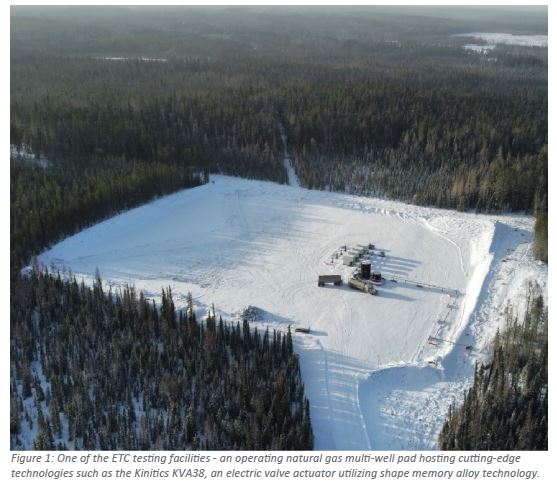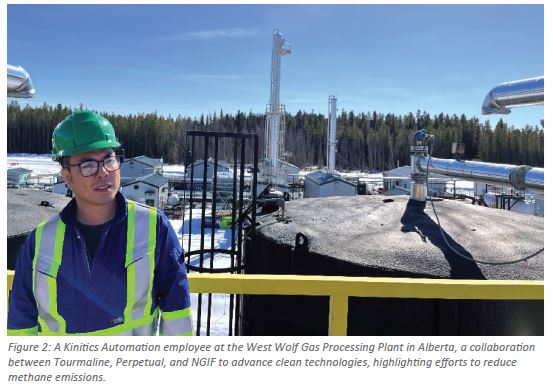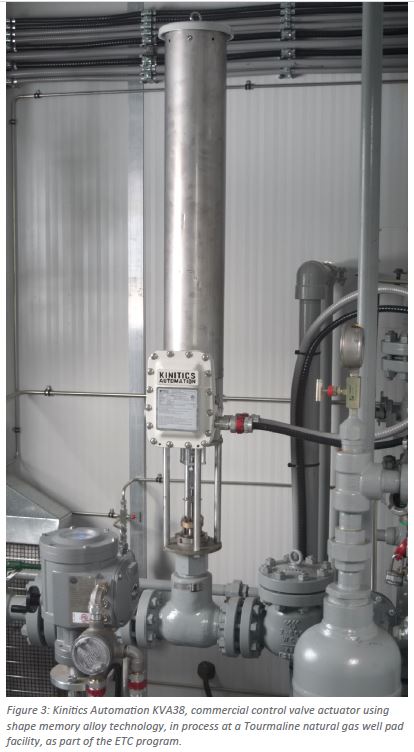Around the world, mitigating methane emissions is emerging as a vital focus in the pursuit of environmental sustainability. Collaborative effort between academia and industry is advancing technology to reduce methane emissions. These initiatives, motivated by new and stringent environmental regulations, represent a significant commitment to addressing a pressing global environmental issue.
By Adam Nguyen, M.Eng. – Kinitics Automation
As countries across the globe navigate the path of environmental sustainability, the fight to curb methane emissions stands as a crucial frontier for innovation. Mitigating methane has been identified as a quick and effective strategy to reduce emissions. In response to stringent environmental regulations, the Emissions Testing Centre (ETC) program, a collaboration among the NGIF Accelerator, Tourmaline Oil Corp., and the University of Calgary, supports research and development aimed at reducing methane emissions.
The ETC program engages with cleantech startups to test and validate advanced technologies focused on methane reduction. By emphasizing practical applications and results, the program seeks to drive forward the development and adoption of technologies that can significantly impact environmental management practices. The initiative fosters a collaborative environment that merges academic research with industry expertise to rigorously evaluate and refine these technologies.
Sustainability Drives Innovation and Technology
At the COP28 UN Climate Change Conference, nations put their focus on methane emissions from the oil and gas sector. Leading the charge, the Canadian and U.S. governments announced ambitious plans to significantly cut methane emissions from the oil and gas sector to meet the Global Methane Pledge. Canada’s proposed strategy aims to reduce oil and gas sector emissions by 75% from 2012 levels by 2030, paralleling the U.S.’s commitment to a near 80% reduction over the same period.
The drive towards stringent methane regulations and standards is not just an environmental objective; it is also a catalyst for industry innovation and competitiveness. Some of these new standards include mitigating practices that contribute to these emissions, including regulating the use of methane-venting pneumatic controllers.

On December 12, 2023, the Environmental Protection Agency (EPA) announced the “Final Rule”, effective May 7, 2024, to significantly reduce methane emissions from the oil and gas sector, including mandating zero emissions from process controllers. Similarly, on December 16, 2023, the Canadian federal government prohibited all venting equipment, with measures coming into force by 2027.
Internationally, the U.S. and Canada’s collaborative stance on methane reduction offers a blueprint for global action, emphasizing the need for new technology. This cooperation sets the stage for industry leaders to pioneer solutions. Leveraging partnerships and cutting-edge technology programs like the ETC are not only aligning with but also advancing the objectives set forth at COP28. This approach highlights a shift in the industry’s mindset – from viewing regulations as a hurdle to seeing it as an opportunity for innovation and leadership in the global transformation for sustainable energy.

New Natural Gas Sector Regulations in the U.S.
The U.S. EPA has refined its regulations to target methane and volatile organic compound (VOC) emissions more effectively across the natural gas industry. These updates specifically address different categories of sources within the industry under Quad Ob and Quad Oc regulations.
- Quad Ob and Quad Oc Facilities:
- Quad Ob targets new/modified sources – facilities that began construction, reconstruction, or modification after December 6, 2022.
- Quad Oc deals with existing sources – facilities constructed before December 6, 2022, and not subsequently modified.
- Zero Emissions Requirement:
- Both Quad Ob and Quad Oc mandate zero emissions from process controllers and pumps, except in Alaska where no onsite power is available.
- Compliance Deadlines:
- Immediate for new/modified sources (Quad Ob): full compliance is required by May 7, 2025.
- Extended for existing sources (Quad Oc): up to 3 years, depending on state or Tribal plan details.

The ETC Program’s Role in Advancing Emissions-Free Valve Actuation Solutions
The ETC program has contributed to the development and commercialization of a control valve actuator developed through this collaboration from concept to market release as a response to new regulations. The introduction of shape memory alloy (SMA) actuation technology in valve actuators offers a new solution to the natural gas industry’s challenge of reducing methane emissions with unique benefits over traditional electric solutions.
The SMA actuation technology features a mechanical spring that ensures reliable valve closures during emergency events such as power outages or signal loss, a critical feature for remote or harsh environments, often seen in the natural gas industry. Moreover, the design incorporates a single moving part for actuation which translates to significantly reduced wear and maintenance, providing a contrast to the complex and maintenance-intensive traditional motorized actuators and pneumatic systems. These qualities are critical for remote locations such as those in the natural gas industry.
The company has conducted extensive field trials, and its technology is now being implemented in commercial operations, including in Tourmaline’s facilities in Alberta. The SMA actuator has demonstrated durability and reliable performance under challenging conditions. This technology represents an advancement in valve control systems and supports environmental objectives by providing the natural gas sector with an alternative to traditional pneumatic actuators that is both efficient and potentially more sustainable.
The Road Ahead
The pathway of environmental sustainability is marked by innovation and strengthened through strategic collaborations. The recent announcement in February 2024 indicated funding of CAD $1.95 million by Prairies Economic Development Canada (PrairiesCan) to the NGIF Accelerator’s ETC, emphasizing a significant commitment to clean technology advancement. This funding enhances the ETC program’s capabilities, supporting innovators in developing technologies that may contribute to more sustainable operations. Highlighting the initiative, Federal Minister Dan Vandal emphasized its alignment with the government’s aim for a Net-Zero economy by 2050, offering cleantech firms a platform to perfect and market their emissions reduction solutions.
As the industry advances toward the 2030 and 2050 environmental goals, the interface between innovation, strategic funding, and regulatory frameworks becomes increasingly critical. The collaboration between government bodies, companies such as Tourmaline, and industry alliances such as the NGIF Accelerator’s ETC program is emblematic of a unified approach to achieving methane emission reductions. This collective effort not only moves the natural gas industry towards environmental compliance but also positions it as a leader in the global transformation for sustainable energy.




